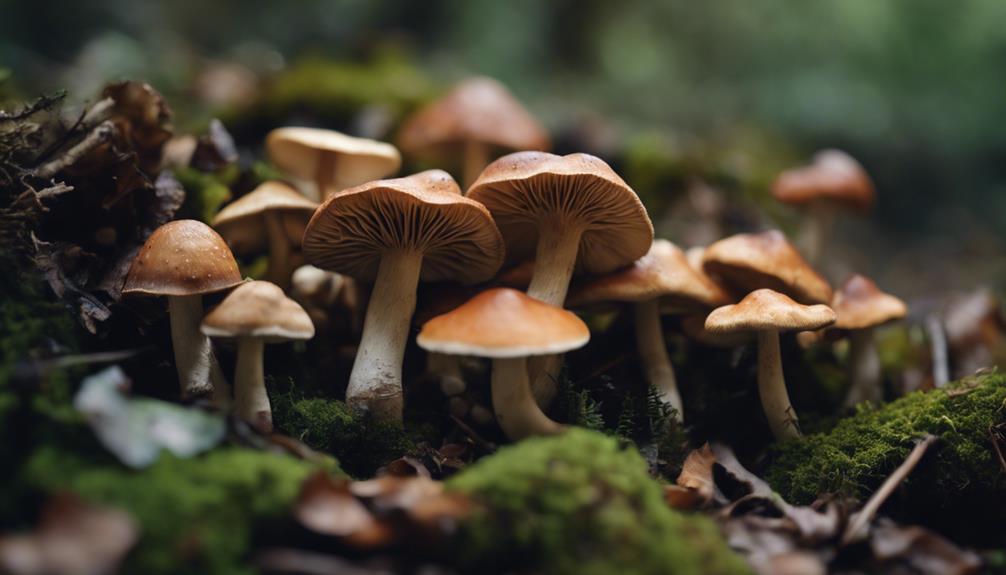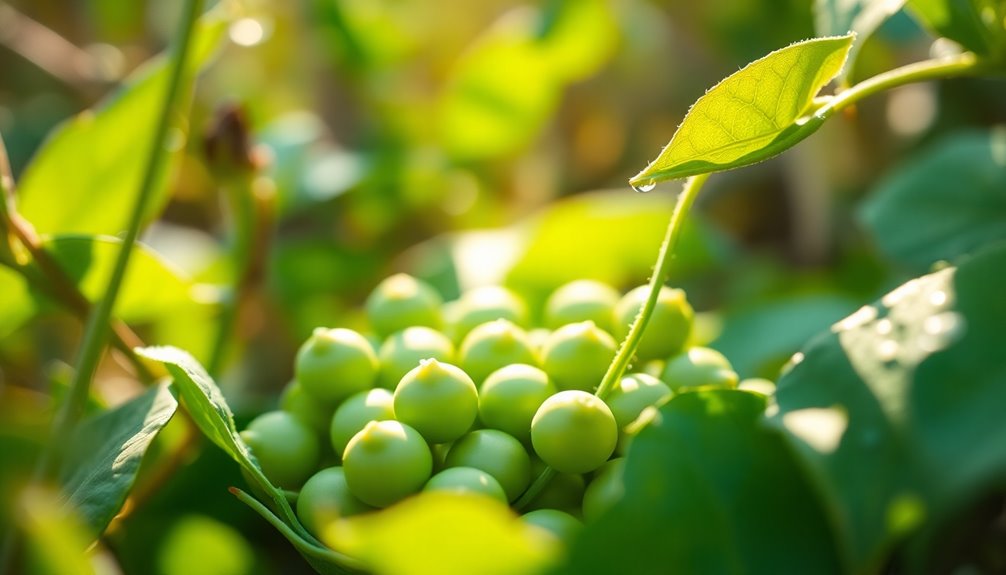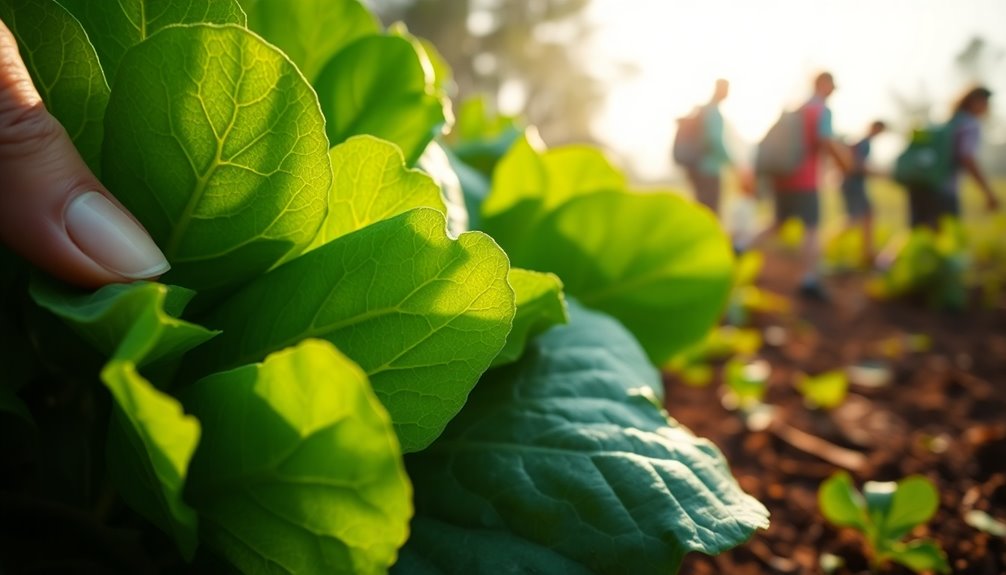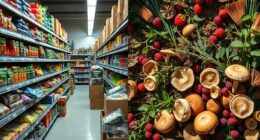Master the skill of mushroom hunting with precision and confidence. Begin by mastering the fundamentals, such as identifying edible mushrooms by focusing on key characteristics and adhering to strict safety guidelines. Delve into top wild mushroom varieties like Morel and Chanterelle for both culinary and medicinal purposes. Arm yourself with essential tools like a knife, basket, and field guide. Hone your skills through spore prints and ethical foraging methods. Expand your knowledge by exploring different cooking techniques to fully appreciate the distinct flavors of wild fungi. Unlock the secrets to becoming a true wild fungi expert.
Key Takeaways
- Master mushroom identification basics for safe foraging.
- Learn about edible mushrooms in North America.
- Utilize guidebooks and workshops to enhance foraging skills.
- Practice safety guidelines and proper identification measures.
- Explore advanced techniques like spore prints and tree associations.
Mushroom Foraging Basics
Mastering the basics of mushroom foraging is essential for your success in identifying safe and edible fungi during your outdoor adventures. When foraging for wild mushrooms, it's important to learn about the different types of edible mushrooms that can be found in North America. Understanding the characteristics of these mushrooms, such as their appearance, habitat, and seasonal availability, is key to ensuring a successful foraging experience.
By enrolling in the workshop, you'll gain valuable insights into the world of mushroom hunting. The sessions will provide you with detailed descriptions and images of edible mushrooms, along with information on safety precautions to take while foraging.
Whether you're a beginner or an experienced forager, the resources offered in the workshop will help you hone your skills and navigate the vast array of mushrooms that can be found in the wild.
With expert-led guidance and practical knowledge, you'll be well-prepared to start on your mushroom foraging journey with confidence and success.
Identifying Edible Mushrooms

To become proficient in identifying edible mushrooms, focus on learning key characteristics and safety measures. When mushroom foraging, it's vital to pay close attention to details such as the cap shape, gills, stem, and overall coloration.
Look for distinguishing features like a skirt-like ring on the stem or a bulbous base, as these can help differentiate between edible and poisonous varieties. The guidebook provides clear descriptions and detailed images to aid in your identification process, along with valuable information on habitats and seasonal availability.
By understanding the unique traits of each mushroom species and their associations with specific trees or environments, you can enhance your foraging skills and confidently select safe options for consumption. Remember, proper identification is important for a successful and enjoyable foraging experience.
Safety Guidelines for Foraging

For safe foraging practices, always prioritize proper identification of mushrooms before consumption. It's essential to carry a field guide or reference material to aid in accurately identifying wild fungi. Beginners should start with easily recognizable mushrooms and avoid consuming unknown species to prevent potential poisoning.
Utilizing online resources or joining local foraging groups can enhance your safety knowledge and skills when exploring the wild fungi landscape. Remember the principle 'when in doubt, throw it out' to avoid any risks associated with misidentified mushrooms.
Safety is paramount when foraging for wild fungi, so taking the time to educate yourself on proper identification techniques and being cautious in your selections is key to an enjoyable and risk-free foraging experience. By following these safety guidelines in your foraging guide, you can confidently explore the world of wild mushrooms while keeping yourself safe and informed.
Top Wild Mushroom Species
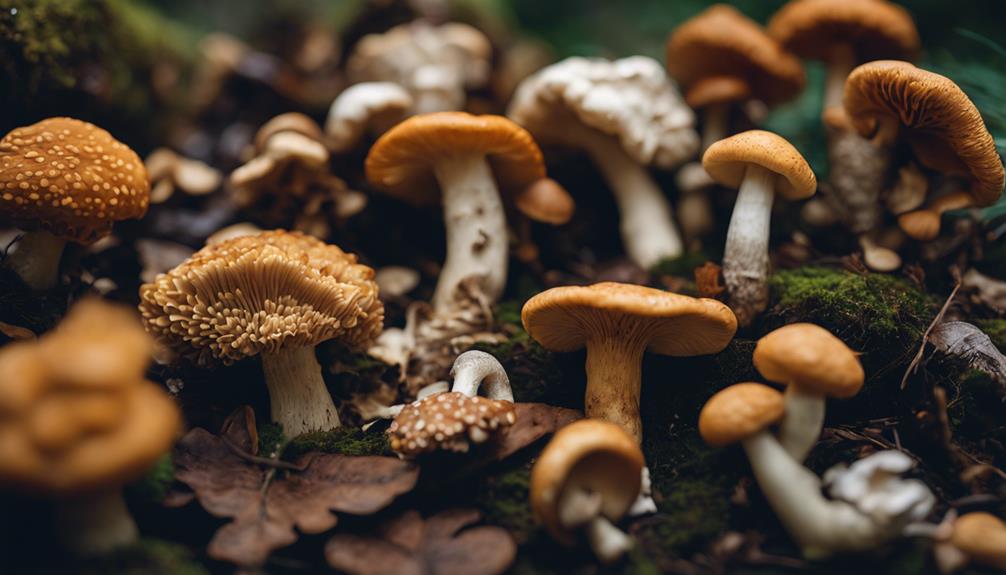
Explore the world of wild mushrooms by discovering some of the top sought-after species known for their unique flavors and appearances. Morel mushrooms, with their distinctive honeycomb look and rich earthy taste, are a favorite among foragers. Chanterelle mushrooms, prized for their delicate apricot-like aroma and meaty texture, are another sought-after wild species. Hen of the Woods mushrooms, growing in large, feather-like clusters, offer a robust, nutty flavor. Chicken of the Woods mushrooms, with their vibrant yellow-orange hues and chicken-like taste when cooked, are also popular finds. Lastly, Lion's Mane mushrooms, resembling cascading white icicles, have a seafood-like flavor.
Beyond their culinary uses, many wild mushrooms have medicinal properties. For example, Lion's Mane mushrooms are believed to promote cognitive function and reduce inflammation. Hen of the Woods mushrooms are known for their immune-boosting properties. Understanding the diverse uses and flavors of these wild mushrooms can enhance your foraging experience and culinary adventures.
Foraging Tools and Equipment
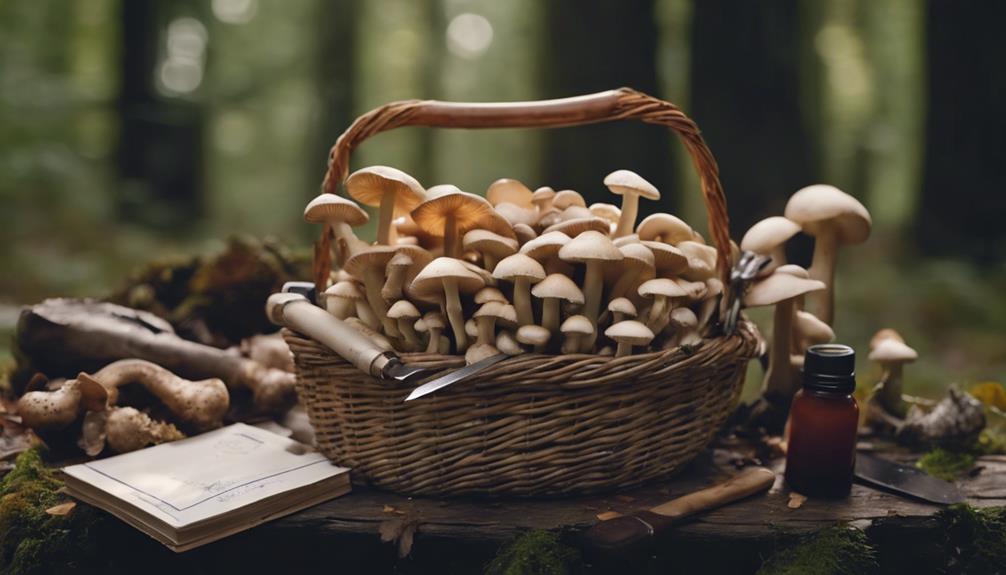
To master the art of mushroom foraging, you must equip yourself with essential gear like a knife, basket, field guide, and small brush. Proper clothing attire is vital to guarantee comfort and protection while moving through forests and fields.
Additionally, following safety precautions such as using a walking stick, compass, and GPS can enhance your foraging experience and keep you safe during your expeditions.
Essential Foraging Gear
When embarking on a mushroom foraging expedition, having the proper foraging tools and equipment is vital for a successful and enjoyable experience. A mushroom field guide is indispensable for identifying wild foods and foraged mushrooms accurately.
Make sure to carry a sharp knife for clean cuts, a basket or mesh bag for collecting mushrooms, and a small brush for cleaning them. Additional foraging tools like a magnifying glass and a compass can aid in mushroom identification and navigation in the wild.
To guarantee your safety and comfort while foraging, it's essential to wear proper clothing such as sturdy boots, long pants, and a hat. Equipment like a GPS device or smartphone can help track your location and mark mushroom spots for future reference.
Don't forget to pack a first aid kit, insect repellent, and plenty of water to stay safe and hydrated during your foraging expeditions. Having the right gear will enhance your foraging experience and help you become a wild fungi expert.
Proper Clothing Attire
Sturdy boots are essential for protecting your feet and ankles while mushroom foraging. When out in the wild searching for mushrooms and wild plants, it's vital to wear long pants and long-sleeved shirts to shield your skin from scratches and insect bites.
Additionally, don't forget to bring along a hat to safeguard your head from sun exposure and unexpected rain showers. Gloves are a must-have for safeguarding your hands against thorns, sharp branches, and potential irritants that you may encounter while exploring.
To guarantee comfort in changing weather conditions, consider dressing in layers and opt for moisture-wicking fabrics that will keep you dry and comfortable throughout your foraging expedition. By dressing appropriately and equipping yourself with the right clothing attire, you can fully enjoy the experience of mushroom foraging while staying protected and comfortable in the great outdoors.
Safety Precautions Needed
Carrying essential foraging tools such as a sharp knife, a basket or mesh bag, a field guide, and a brush is important for a successful mushroom hunting expedition. In addition to these tools, safety precautions are essential for a safe and enjoyable foraging experience.
When starting on foraging expeditions, it's recommended to wear appropriate clothing and sturdy footwear. Carrying a whistle can be a lifesaver in case of emergencies. Avoid using plastic bags for collecting mushrooms, as they can cause mushrooms to degrade quickly. To prevent getting lost, having a compass or GPS device, along with a map of the foraging area, is crucial.
Lastly, being prepared for any unexpected situations is key. Carrying a small first aid kit, insect repellent, and sunscreen ensures you're ready for anything that may come your way during your mushroom foraging trips.
Preserving and Cooking Mushrooms

Learn essential techniques for preserving and cooking mushrooms during the workshop. When it comes to preservation techniques, the workshop will cover various methods to help you store mushrooms for extended periods. From drying to pickling, you'll discover ways to make the most out of your foraged fungi.
Moving on to cooking methods, detailed instructions will be provided on how to cook mushrooms to enhance their flavors and textures. Whether you're sautéing, roasting, or grilling, you'll learn the best practices to bring out the unique qualities of each mushroom type. Additionally, tips on selecting the right cooking methods based on the characteristics of different mushrooms will be shared.
Advanced Foraging Techniques
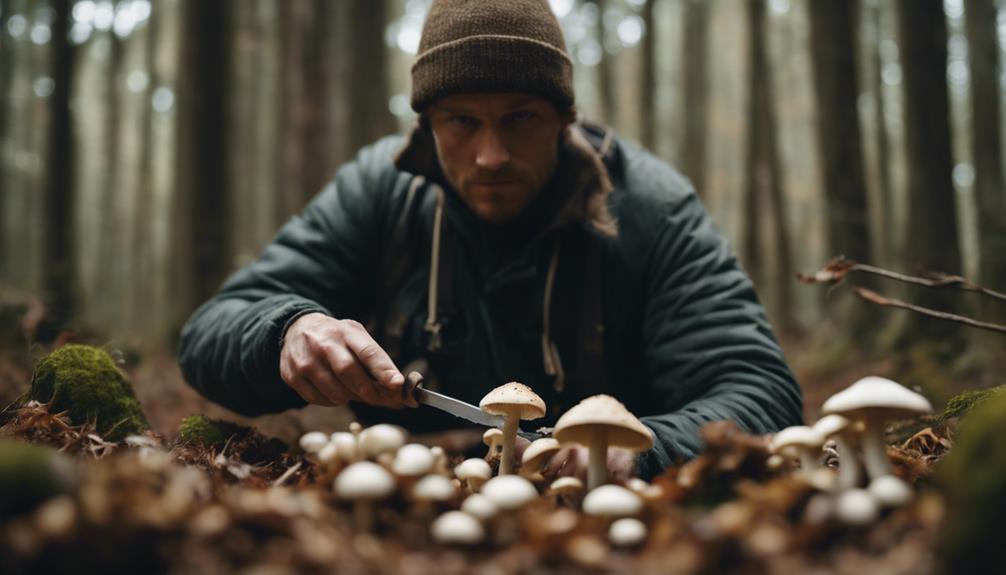
Master the art of identifying wild mushrooms with advanced foraging techniques based on spore prints and tree associations. Understanding spore prints involves placing the cap of a mushroom on paper, allowing it to release spores, which can help in determining the species.
Tree associations are essential as different mushrooms have symbiotic relationships with specific tree species, aiding in their identification. When harvesting wild mushrooms, always consider ethical guidelines, like not overharvesting and respecting the environment. Sustainable practices guarantee the continuation of mushroom growth for future foragers.
To preserve your foraged treasures, explore methods like drying, pickling, or freezing, which can extend the shelf life and flavors of wild mushrooms. Experiment with cooking techniques and recipes to bring out the unique tastes of various wild mushroom species.
Gain valuable insights from experienced foragers on effective hunting strategies, safety precautions, and best practices for successful foraging trips. Keep honing your skills to become a proficient wild fungi expert.
Frequently Asked Questions
What Is the Most Lucrative Mushroom?
The most lucrative mushroom is the truffle, prized for its unique flavor and aroma. Truffle hunting, often with trained dogs or pigs, is a specialized skill. The most expensive truffle ever sold fetched $330,000 at auction.
Is Mushroom Foraging Safe?
Mushroom foraging can be safe if you accurately identify edible species and follow foraging guidelines. Attend workshops, carry a field guide, and seek expert advice to guarantee a secure experience. Remember, caution is key.
How Do You Become a Mushroom Hunter?
To become a mushroom hunter, research local edible varieties, acquire proper tools, join mycology clubs, attend workshops, and prioritize safety. Learn from experienced foragers, explore guided tours, and always double-check identifications to enjoy a safe foraging experience.
What Are the Rules for Mushroom Foraging?
When mushroom foraging, always know the rules. Check permits, identify safely, and respect property boundaries. Take only what you need, leave no trace. Remember, education is key. Join a society or tour for guidance.
Conclusion
Now that you've mastered the art of mushroom foraging, the forest is your oyster. With your newfound expertise, you can confidently identify, harvest, and cook a variety of wild fungi.
Remember to always prioritize safety, follow guidelines, and respect the environment. So grab your basket and knife, venture into the woods, and commence on your next mushroom hunting adventure.
Happy foraging!


